
views
Covering Your Washer & Dryer
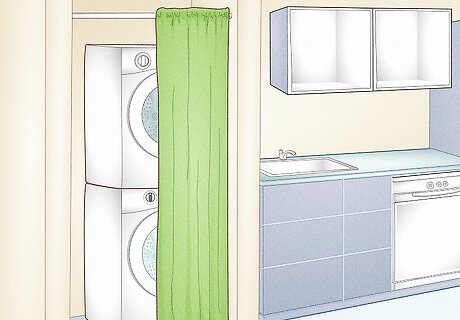
Hang a full-length curtain to conceal your appliances. This works best if your appliances fit into their own space with walls on both sides, and will work with both free standing or stackable units. Use a tension or closet rod to hang the curtains from. Select a curtain that is long enough to cover almost the entire length from the ceiling to the floor, and coordinates with your kitchen so it doesn’t look out of place.
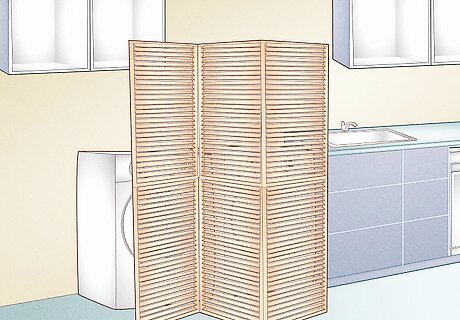
Set up a free-standing room divider to separate your laundry area. You can purchase either a single-panel divider or a multi-panel divider, depending on the look you want and the space you have. Use a single panel divider if you have the space to keep it in one spot, and still have enough room to move around when the appliance doors are open. Use a multi-paneled, folding divider to place directly in front of your appliances. Simply fold it up and set it to the side when you need to do laundry. For a more permanent solution, hire a local contractor to build a wall on either side of your washer and dryer. Then, put a folding door on the front, so the area will just look like a small closet.
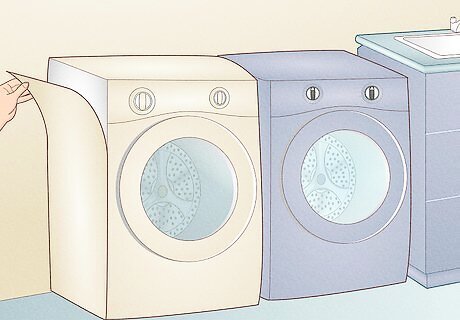
Apply vinyl covering to your appliances to help them blend in. If you aren’t able to conceal your washer and dryer, make them a part of your decor. You can wrap the appliances completely in a solid or patterned vinyl, or use smaller decals available in various sizes and designs. Applying the vinyl is typically very simple—clean the area, remove the backing from the vinyl sheet, and stick the vinyl to the appliance. Be sure to follow the included directions.
Hiding a Washer & Dryer in a Closet or Pantry
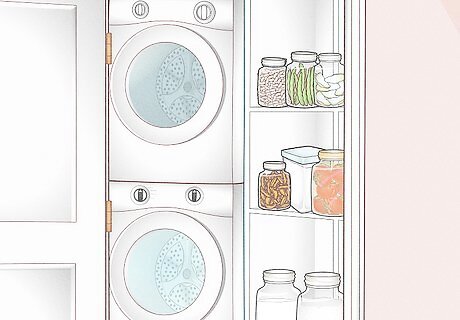
Put a stacking washer and dryer in a large pantry with the food. Use one side of the pantry for your laundry appliances, and the other side to store your food. Depending on the layout of your pantry, you may have to modify the shelving to make space for your washer and dryer. If it will fit, you may be able to put side-by-side units in the pantry, and have top shelving for food storage.
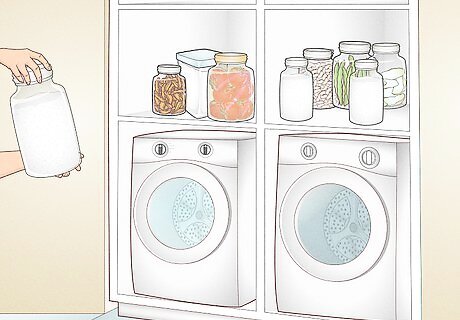
Move pantry items to other cupboards to make room for your appliances. You will need to rearrange your kitchen cupboards to free up space to store food. Once this is done, you can move your food items out of the pantry, and your washer and dryer into it. Maybe you have one cupboard for plates and bowls, and another for drinking glasses. Think about ways that you might be able to combine the items in the cupboards; perhaps you can move everything to one cupboard and put plates and bowls on a bottom shelf, and glasses on the second shelf. This might be a good time to declutter and get rid of dishes that you rarely or never use.
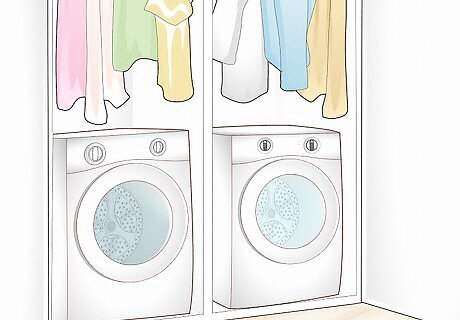
Hide your washer and dryer in a nearby closet. If you have a double-sized closet, this should be no problem. You can still keep shelving and hanging rods above the appliances to use for extra storage space. Even if you have a small, single-sized closet, a compact, stackable washer and dryer set will still fit; you may just need to find another closet or storage area for your other items. Hide the appliances when you are not doing laundry by simply closing the door. If the closet doesn’t have a door, you could conceal the area by hanging a curtain in the doorway, or make a big statement by adding sliding barn doors.
Installing Appliances in Your Counter Space
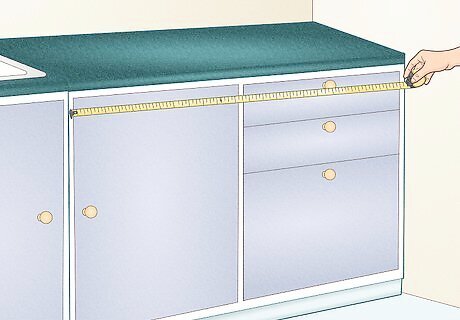
Measure your counter space to determine if you have room to install appliances. If you plan to install a front loading washer and dryer underneath the countertops (as opposed to taking out a section of cabinetry), be sure your counters are high enough and deep enough to accommodate the appliances. Think about how you can rearrange the items in your cabinets to make space for the appliances. Consider the layout of your kitchen and where it would make the most sense to remove cabinets and/or drawers to make room if necessary.
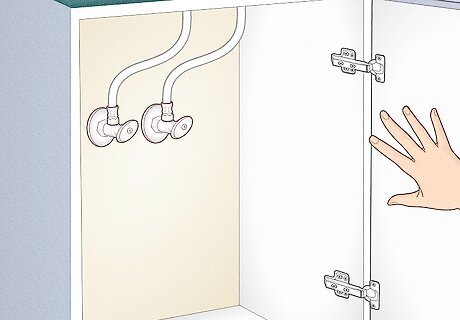
Locate your water connections if you are installing a washing machine. The good news is that kitchens already have plumbing, so you’ll just need to plan to install your washer near the existing supply lines.

Choose an exterior wall for proper ventilation if you are installing a dryer. To avoid the risk of fire, most dryers will need to be installed in a space where it can use an existing vent or window to get rid of the exhaust. If installing the dryer on an exterior wall is not an option, consider purchasing a ventless dryer. These dryers are more compact and will definitely fit under your countertops, but the downside is that they may take longer to dry your clothes.
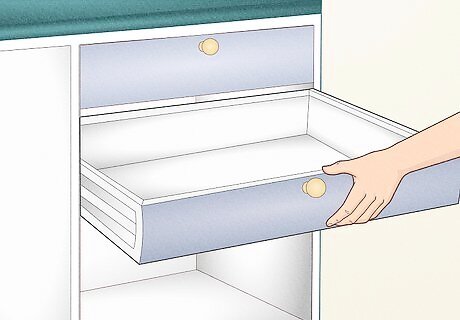
Remove sliding drawers and cabinets to make room for the appliances. After unhinging drawers and cabinets and removing all slides and tracks from the cabinetry, use a jigsaw or circular saw to remove the rest of the wood and finish carving out the space. A wood blade will cut the wood if you are just removing extra wooden pieces to install your washer and dryer underneath the existing counter, as well as cut laminate countertops if you are completely removing a section of the counter. Be sure to wear proper protective gear like safety glasses and gloves.
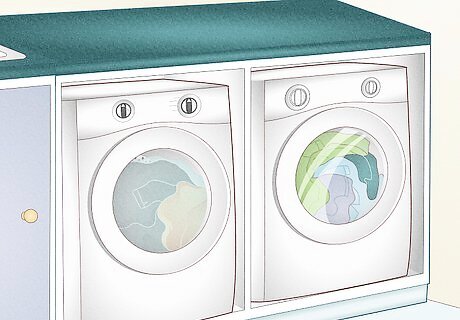
Connect your appliances and run a test cycle. It may be a good idea to have a plumber or electrician make all of your connections to ensure it is done properly. If you have the proper experience, you can make the connections yourself. Do a test run on the appliances you are installing to make sure all cycles are working properly and there are no issues, like leaks, before sliding them into place.
Adding a Countertop to Front-Loading Machines

Measure your washer and dryer. You’ll need to know the depth from the front to the back of the machines, as well as the entire width of both machines combined. If your machines are placed in a space between two walls, measure from one wall to the other wall. You may be able to find the countertop material that is already the correct size you need. If not, you may have to do some minor cutting with a handsaw to trim it to size. Be sure to wear proper protective gear like safety glasses and gloves.
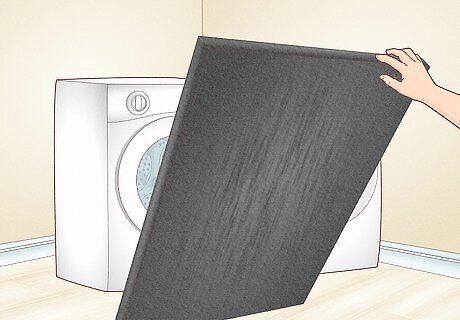
Decide what type of material you want for your countertop. You can install a plain sheet of white laminate, stained plywood, butcher block, or stock laminate countertop from your local home improvement store. Depending on the quality of the products you choose, you can install either of these options for under $100.00, but prices can range up to $400.00.
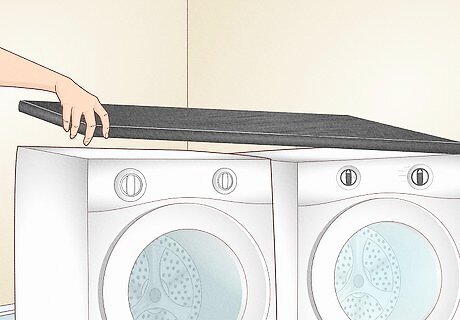
Set the countertop directly on top of your washer and dryer. It’s that simple! Use the countertop to hold laundry items like detergent and dryer sheets, and also use it as a folding area. If your washer or dryer tends to shake a lot during cycles, try covering the top of your appliances with non-slip shelf liner before topping with the countertop. This will prevent the countertop from sliding. Alternatively, if your appliances are between two walls, you can attach 2 in x 2 in (5.08 cm x 5.08 cm) wood strips to the surrounding walls, about 1 inch (2.5 cm) above your appliances, to use as support and protect the top of your machines.
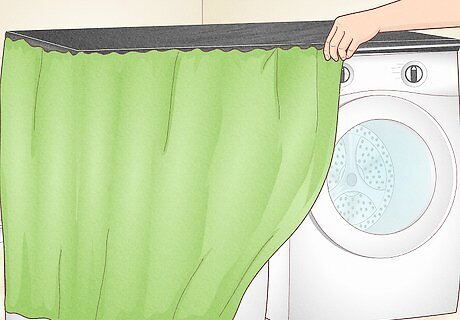
Add curtains to further conceal the appliances. Hang curtains directly below the countertop using a tension rod if the machines are between two walls. Simply slide the curtains to the side when it’s time to do laundry.




















Comments
0 comment